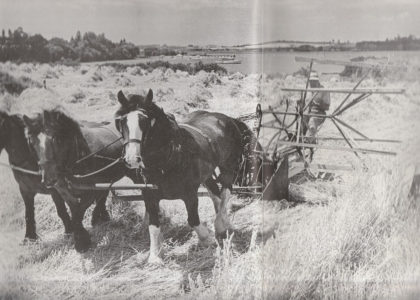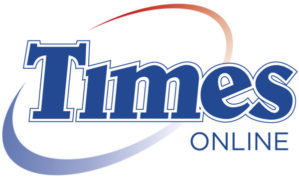
Pakuranga’s last wheat and oats harvest in 1947 was by horse-drawn reaper and binder.
It stirred up nostalgic memories for many as we all accept times are changing.
More than 100 years ago Pakuranga was well-known for its fields of golden wheat, harvesting up to 60 bushells an acre, equal with the best in New Zealand.
But the high humidity and the fungus rust in 1914 forced many farmers to consider sheep or dairy cattle as an alternative income.
Some sent their milk to be separated for butter which also provided skim milk for calves and pigs.
A few farmers like Dufty Bell and his cousin Herb Fergusson tried other wheat varieties, but the Pakuranga wheat was not good enough for flour milling and, instead, was used as food for pigs, cattle, poultry and horses after mixing with oats and chaff.
The flour millers of Auckland had blended grain with South Island grains for the expanding biscuit industry such as the large Otahuhu Bycrofts Biscuit Company making many biscuit varieties.
When the first Fencible settlers arrived in Howick, they were given a free bag of wheat for their one-acre allotments. They cut their mature wheat using a sharp reaping-hook or sickle, laying it down carefully to be made into a stook to dry it out before flailing out the grains on a canvas sheet.
The grain was ground in an iron Emigrants Wheat Mill or sent to Partington’s Windmill in Auckland. Larger homesteads like Bleak House used large hand-operated wheat mills. Some ground their oats after soaking in water overnight, to make porridge next morning.
Captain Smith of Bell House, and other farmers, found caterpillars and potato moth destroyed their entire potato crops.
In the 1870s, the Howick Acclimatisation Society introduced insectivorous birds such as sparrows, blackbirds, thrushes, starlings and finches. But after sowing, and particularly at harvest time, clouds of sparrows descended to eat their crops and it was a major curse.
In the Great Depression of the 1930s, some farmers used to have sparrow-pie!
For many years wheat and oats were cut, tied into bundles, then stoked to dry and made into large stacks. These were thatched with six-inch thick bundles of raupo to keep the rain out until the threshing machines arrived.
Hattaways in Botany Road grew wheat for more than 50 years. The Rt Hon Bill Massey, our Member of Parliament and later Prime Minister (1912-1925), used to follow his sons steam traction engine hauling their threshing machine from farm to farm.
More than 20 farms were growing wheat in the 1880s in Pakuranga. At mealtimes he would join the workers campaigning which paid good dividends at election time. Meals for hungry workers provided by the farmer were a great feast with mountains of food and gallons of hot tea.
Along the Pakuranga Creek there were several crude wharves where cutters moored at high tide. Only one wharf remains today near Ti Rakau Bridge.
Bags of wheat were slid down polished chutes to the cutter which would sail on the next high tide down to the Tamaki River and Auckland to be sold to merchants.
The Pakuranga Creek was mangrove-free until the 1940s but runoff has reduced the navigable stream. The once productive fields of golden grain are now covered with suburban houses.
Alan La Roche
Howick Historian
alanlaroche@xtra.co.nz







